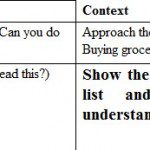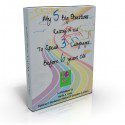Tags, Taglines, Tagging, Tagger And Tagged For Price, Facebook, Bag And English (Part 1)
How To Use Tags To Help Us Teach Kids
Imagine teaching a child the word “assignment”.
In most cases, children in the upper primary and secondary levels are given not only homework but also projects. They definitely understand the word homework to mean work given by the teacher to be completed at home. Assignment does not mean homework but the reverse is true, homework is assignment. Hence, assignment can be used a tag and thus homework to be the specific type of assignment.
Another word is drinks. Drinks can be anything from hot to cold drinks or beverages to juices. Drinks can be used as a tag and carrot juice is the specific type of drink. Similarly, ‘flour’ is the tag whilst ‘rice flour’ and ‘potato starch’ are specifics. Supermarkets are great examples of the use of tags. The words ‘beverages’, ‘baking needs’, ‘poultry’, ‘fruits’ etc are clearly displayed on signboards.
Think of it also as the main point of our speech. In Tedtalks, speakers use a tag on their slides and talk around it. They can stay focus and the audience stay engaged with the main point of their talk.
Teaching Mandarin or Chinese Language Using Tags
From the examples above, apparently tagging as a method to teach kids renders control and focus on a subject matter. However, when I teach Mandarin vocabulary , I have to improvise for obvious reasons. Mandarin or Chinese language is pictorial. Therefore a character represents a certain and specific image, tangible or intangible. The word tag itself has many different uses and meanings in Mandarin depending on what context or subject matter we are talking about. So it is even harder to arrive at a common word to replace ‘tag’.
Keeping in mind that the goal is to learn the list of vocabulary words in Mandarin. Instead of learning the meaning of a character, I teach my daughter to pick only one word that gives it meaning and remember only that word. So if 标签 (biao1 qian1) a meaning for tag, I tell her to remember 签 for signature and 标 for sign or symbol. In other words, it is easier to remember 标签 if she remembers signature or symbol but not the word tag.
If Learning Is An Intuitive Process, Tagging Is The Way To Go.
If you are still wondering why kids seem to remember things faster after an hour at the shopping mall than 2 hours at the desk reading an English passage, it is because information has been used more effectively in the shopping malls. Tagging is found everywhere.
In McMillian Dictionary,
tag (verb) means to attach a small piece of paper or other material to something to give information about it
I realise the importance and usefulness of tags of late. I reckon that a child will understand and learn faster if we use tags in our teaching process.
If we don’t need any help to recognise a good bargain or discount when we see one, there must be some way information is translate it into learned action. The sense of sight for something so special is so influential and engaging that we don’t need any lesson to help us recognise a price tag that says discount or sales! This is purely an intuitive process. Intuitive response is the most powerful method to learn anything. It goes deep into our subconscious mind, we act spontaneuously instead of impulsively. Impulse buying as a result of discounts is rarely heard of. But impulse buying because of desire to own is more common and this often leads to regret. But impulse buying as a result of discounts or sales always leads to triumph! ‘That was a great buy?”
Reading Technique
 Reading techniques need to be changed. We can no longer expect our kids to read novels and books to learn about the world around us. They do not need us to tell them a whole lot to learn new knowledge these days. They can find the answers on the computer via the world wide web. Tagging has made it impossible to escape the obvious; comprehension problems. Tagging on Facebooks, articles for blogs, news, articles on the internet have created a wave of learning that is hard to keep track.
Reading techniques need to be changed. We can no longer expect our kids to read novels and books to learn about the world around us. They do not need us to tell them a whole lot to learn new knowledge these days. They can find the answers on the computer via the world wide web. Tagging has made it impossible to escape the obvious; comprehension problems. Tagging on Facebooks, articles for blogs, news, articles on the internet have created a wave of learning that is hard to keep track.
A 12 year old child understand tagging faster than we have time to explain. There is no need to learn what’s behind the tagging process; the very fact that a person is tagged on a photograph is true recognition of one’s existence in the community. There is no learning curve, it is a simple dot.
Less and less people are talking about what they have read. More and more people are discussing what they have heard or watched on the news. If someone tells you they learn about a plane crash (Malaysian Airlines MH370), rarely do they quote the Straits Times papers. It was on the television news and youtube. All it takes is a few search words that are tagged for you to get to the news update.
Can We Teach Kids The Art Of Tagging?
I should hope so. It would be just wonderful. It is a step forward to getting kids to think less yet learn more.
Lets say, in a paragraph, instead of trying to understand the main points, a child can be asked to highlight a few keywords and learn to use tags against the keywords. Then the child is asked to come up with phrases using the tags before writing his own sentences. This is far more effective than to get the child to question or give a full summary of the main points of the paragraph, in their own words. One has to be fairly proficient in a language to summarise a paragraph let alone retell a story in one’s own words.
Keywords, tags, phrasings and then a few sentences. The operatives are so connected, it is hard to imagine any child can fail trying. A child can google for information without any professional help. Its time to wake up to the process and start following how the child speaks his or her mind.
Follow the child: Maria Montessori
End of part 2: Tags, Taglines, Tagging, Tagger And Tagged For Price, Facebook, Bag And English (Part 2 Of 2)
Back to Part 1: Click Here
Or Shop For Products On This Website: Click Here


